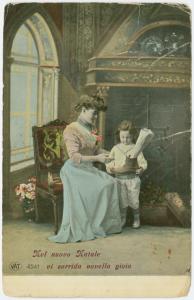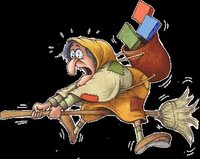
Christmas Traditions in Celenza Valfortore: 1920's
We are truly blessed to have John Augelli, who was born in Celenza Valfortore and came to America in 1929, share some of his childhood memories with us of Christmas time in Celenza. Thank you, John, for your generous spirit!
"Christmas in Celenza was a family oriented, primarily religious observance. There was no exchange of gifts among the adults or giving toys to children. A gift of food might be sent to a poor family, but even this was not generally done.
The celebration began on the eve of Christmas when the family gathered. There was a roaring fire which served both to heat the house and to cook. The traditional Christmas eve meal called for seven different courses but no meat. Emphasis was on fish such as eels and cod (bacala') and other fish varieties that had been brought in just for the occasion. (Ordinarily, fresh fish was not available. People relied on dried and salted varieties such as cod, sardines and herring.) In addition there might be pasta, cooked greens (minestra), chic peas (ceci), fruit, chestnuts, and baked items such as taralli.
After the meal, there might be singing of Christmas carols, or card playing. The children were sent to bed early so that they could attend the dawn mass. The mass itself was a special affair with the singing of traditional Christmas songs and the kissing of baby Jesus. (A doll representing the Christ child was held by the priest at the altar and the congregation filed to the altar to kiss it). A special presence at the mass and throughout the Christmas season was the elaborate nativity scene (presepio). The nativity scene included special lighting and dozens of figurines of people, animals, and landscape features and was very much an art form. Some of those figurines were centuries old and were passed on from one generation to another.
On Christmas Day the house would be prepared to receive the many friends and relatives who came to wish the family a `buon Natale.' The visitors were always offered licuori or wine and baked goodies. Christmas dinner was very special and included all the traditional dishes from antipasto, to soup, meat, pasta cakes and cookies and, of course, wine. (Fresh meat was not eaten every day, but if the family could afford it, there was always a meat dish at Christmas dinner.) The gargantuan meal was generally followed by a siesta, and with that, Christmas was essentially over."
The Yule Log: Il Bruciamento del Ceppo di Natale
This recounting of the tradition of the Yule Log is based on a loose translation of Christmas traditions in Celenza and San Marco la Catola available on Celenza Valfortore and San Marco la Catola online .
The period between Christmas and New Year's (Capodanno) is a most sacred time, in which one ends the year with the purifying of the house for the arrival of the New Year and to remember the birth of Christ. Many older people remember this tradition well.
On Christmas Eve, the head of the family would choose a large and dry log and would then burn it for the entire evening. He would first prepare the fireplace with well arranged logs and circle the Yule Log with smaller logs that helped it burn constantly. The older people remember that the number of logs was strictly fixed: 12 smaller logs to represent the apostles and the largest log to symbolize Jesus. At night on Christmas Eve, the head of the house would ignite the Yule Log, and it would burn all night to purify the house. To the children, the older people would say that the log burned because the Holy Family was in the street and was arriving, and seeing the log burning, they would find a hospitable house where they could warm themselves and eat.
Christmas Traditions in Celenza Valfortore: Today
This short description of Christmas traditions in modern day Celenza is based on a loose translation from a letter of one of our friends who currently lives there.
The Christmas celebrations begin here on Christmas Eve, the night of the Vigil. We go to mass in the evening, and then, upon returning, we open gifts under the tree, sing Christmas carols, toast to each other's good health, eat panettone and then visit with friends.
On Christmas day, we all have "pranzo" together (to call this meal lunch would not do it justice). The entire family is all there, almost twenty people! It is a most beautiful and magical atmosphere, especially when it snows, and it often happens.
In the afternoon, we visit relatives, bring them good wishes, laugh, joke and eat. We eat torrone, panettone, frittelle, mostaccioli and drink in the good company of our friends and family.
La Befana
La Befana, the Christmas witch, is a fairly recent addition to Celenzano Christmas traditions. While this tradition was not widely observed in Celenza at the turn of the 20th century, today the young children look forward to her arrival on the eve of the Epiphany, January 6th. The legend is that La Befana, an old witch, flies on a broom, bringing candy and toys to the children. She usually leaves a lump of coal, which is, in reality, rock candy colored with caramel. Unlike Santa, who seems only to threaten to bring coal, La Befana works on the assumption that at some point all children can be a little naughty!
One legend regarding La Befana is that the three kings stopped at her house on the way to present baby Jesus with gifts. La Befana was invited to join the kings, but she declined. She then deeply regretted it and searched for the kings to join them in their journey. Because she never found them, she continues to search for baby Jesus, leaving all children gifts of toys and candy.

For more on La Befana, here are some links: La Befana: Wikipedia, La Befana: past and present, La Befana (Italian language site).